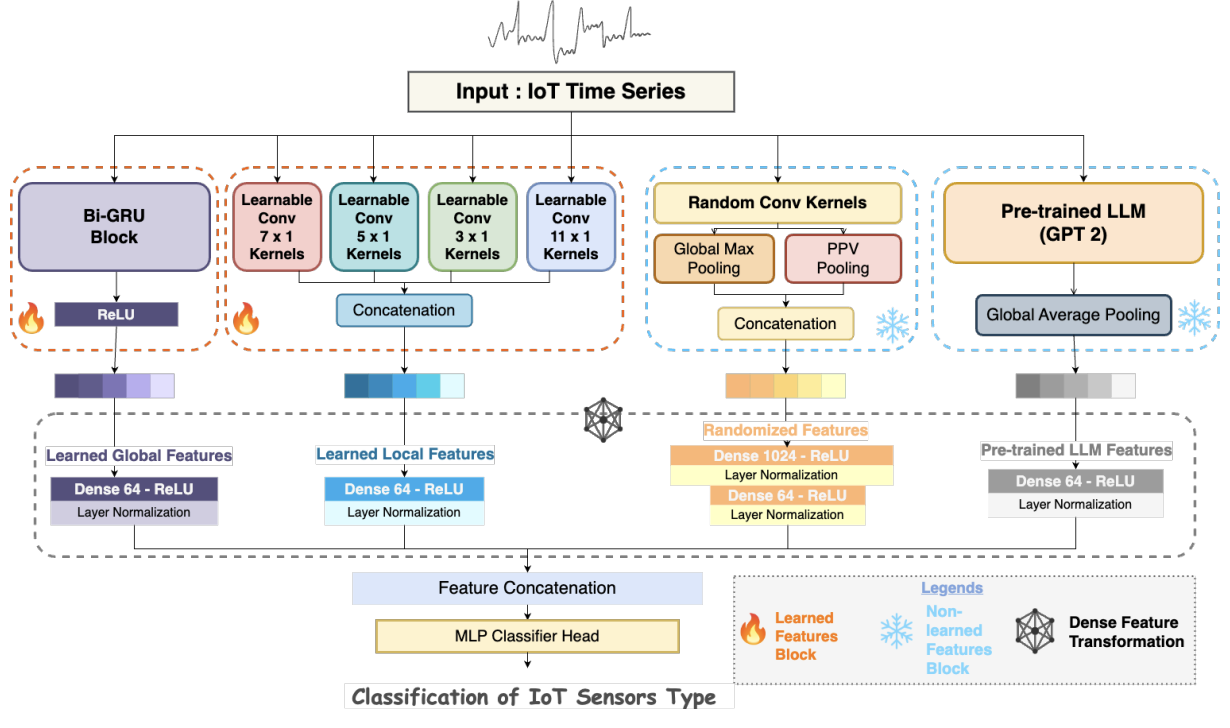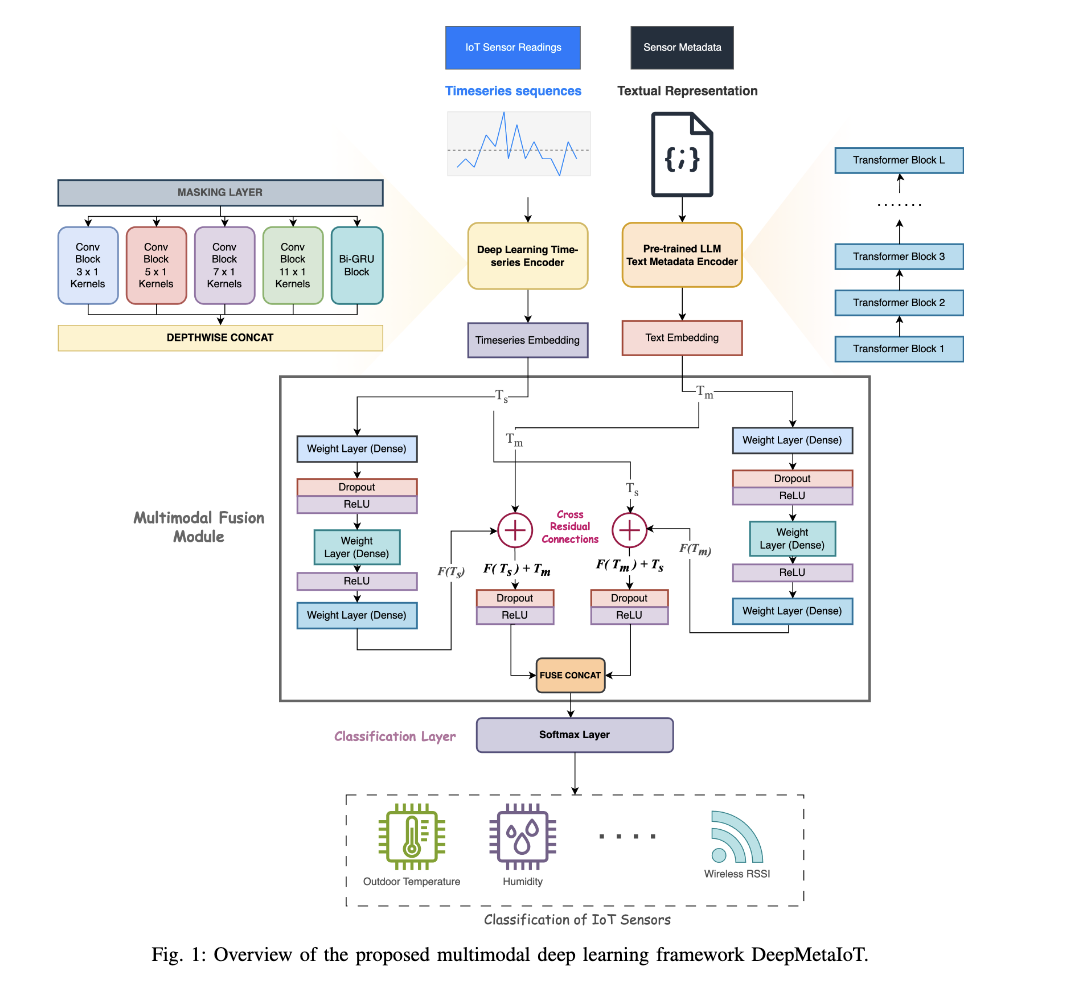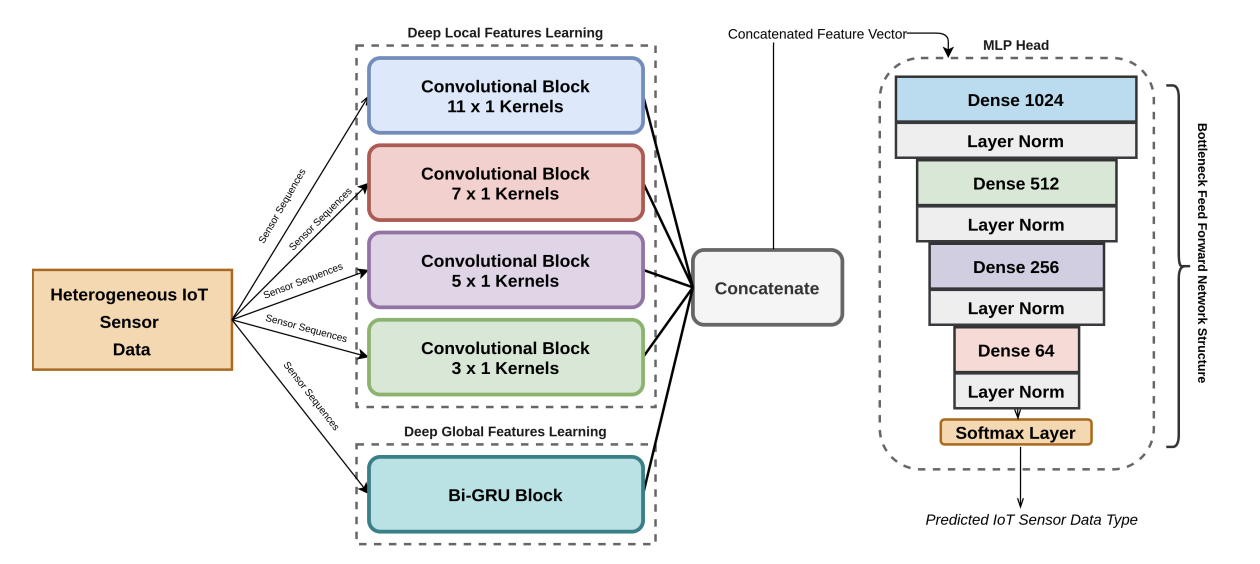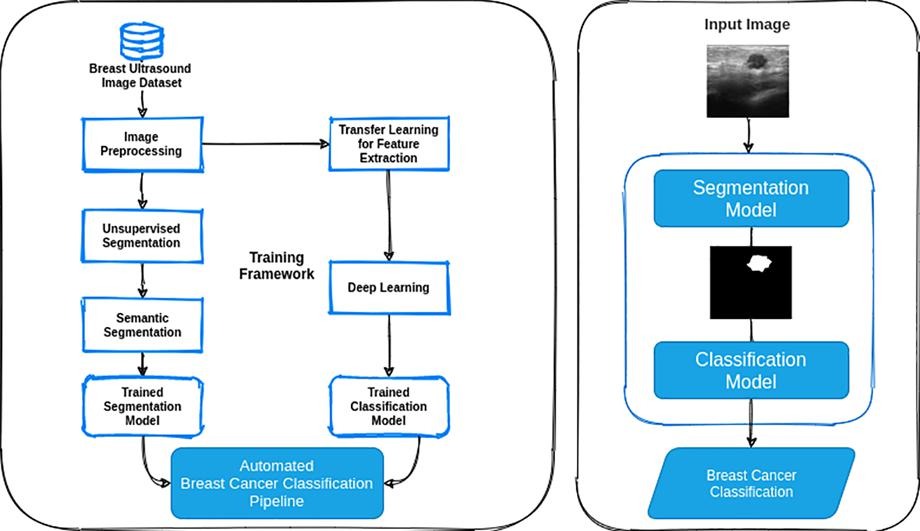publications
publications by categories in reversed chronological order. generated by jekyll-scholar.
2025
- DeepFeatIoT: Unifying Deep Learned, Randomized, and LLM Features for Enhanced IoT Time Series Sensor Data Classification in Smart IndustriesMuhammad Sakib Khan Inan and Kewen LiaoIn Proceedings of the Thirty-Fourth International Joint Conference on Artificial Intelligence, IJCAI-25, Aug 2025AI4Tech: AI Enabling Technologies
Internet of Things (IoT) sensors are ubiquitous technologies deployed across smart cities, industrial sites, and healthcare systems. They continuously generate time series data that enable advanced analytics and automation in industries. However, challenges such as the loss or ambiguity of sensor metadata, heterogeneity in data sources, varying sampling frequencies, inconsistent units of measurement, and irregular timestamps make raw IoT time series data difficult to interpret, undermining the effectiveness of smart systems. To address these challenges, we propose a novel deep learning model, DeepFeatIoT, which integrates learned local and global features with non-learned randomized convolutional kernel-based features and features from large language models (LLMs). This straightforward yet unique fusion of diverse learned and non-learned features significantly enhances IoT time series sensor data classification, even in scenarios with limited labeled data. Our model’s effectiveness is demonstrated through its consistent and generalized performance across multiple real-world IoT sensor datasets from diverse critical application domains, outperforming state-of-the-art benchmark models. These results highlight DeepFeatIoT’s potential to drive significant advancements in IoT analytics and support the development of next-generation smart systems.
@inproceedings{Inan2025DeepFeatIoT, title = {DeepFeatIoT: Unifying Deep Learned, Randomized, and LLM Features for Enhanced IoT Time Series Sensor Data Classification in Smart Industries}, author = {Inan, Muhammad Sakib Khan and Liao, Kewen}, booktitle = {Proceedings of the Thirty-Fourth International Joint Conference on Artificial Intelligence, {IJCAI-25}}, publisher = {International Joint Conferences on Artificial Intelligence Organization}, editor = {Kwok, James}, pages = {9223--9231}, year = {2025}, month = aug, note = {AI4Tech: AI Enabling Technologies}, doi = {10.24963/ijcai.2025/1025}, url = {https://doi.org/10.24963/ijcai.2025/1025}, } - DeepMetaIoT: A Multimodal Deep Learning Framework Harnessing Metadata for IoT Sensor Data ClassificationMuhammad Sakib Khan Inan, Kewen Liao, Haifeng Shen, and 3 more authorsIEEE Internet of Things Journal, 2025
Internet of Things (IoT) sensor data, which capture time series physical measurements such as temperature and humidity, often lack proper classification. This limits their effective understanding, integration, and reuse. While sensor metadata—textual descriptions of the measurements—is sometimes available, it is frequently incomplete or ambiguous. As a result, classification often depends solely on the time series data. Leveraging both time series sensor readings and textual metadata for automated and accurate classification remains a challenge due to the heterogeneity and inconsistency of these data sources. In this paper, we propose DeepMetaIoT, a multimodal deep learning framework that integrates time series and textual data for classification. DeepMetaIoT employs a cross-residual architecture comprising a time series encoder and a text encoder based on a pre-trained large language model, enabling effective fusion of both modalities. Experimental results on real-world IoT sensor datasets show that DeepMetaIoT consistently outperforms state-of-the-art machine learning and deep learning baselines.
@article{Inan2025DeepMetaIoT, author = {Inan, Muhammad Sakib Khan and Liao, Kewen and Shen, Haifeng and Jayaraman, Prem Prakash and Montori, Federico and Georgakopoulos, Dimitrios}, journal = {IEEE Internet of Things Journal}, title = {DeepMetaIoT: A Multimodal Deep Learning Framework Harnessing Metadata for IoT Sensor Data Classification}, year = {2025}, volume = {}, number = {}, pages = {1-1}, doi = {10.1109/JIOT.2025.3595556}, issn = {2327-4662}, month = {}, }
2024
- A slice selection guided deep integrated pipeline for Alzheimer’s prediction from Structural Brain MRIMuhammad Sakib Khan Inan, Nabila Sabrin Sworna, AKM Muzahidul Islam, and 6 more authorsBiomedical Signal Processing and Control, 2024
Alzheimer’s disease, a progressive form of dementia, has risen to become the fifth leading cause of death among individuals aged 65 and older. The diagnosis of Alzheimer’s is both time-consuming and costly, involving radiologists and clinical experts at multiple stages, which presents a significant challenge in the medical field. Moreover, cases of Alzheimer’s and dementia often go undiagnosed or misdiagnosed worldwide. To address this issue, medical experts meticulously analyze patients’ structural MRI (sMRI) scans to identify potential abnormalities linked to Alzheimer’s or other forms of dementia. Recognizing the devastating impact of this disease on people’s lives, Artificial Intelligence (AI) researchers have been dedicated to developing automated solutions for early-stage Alzheimer’s diagnosis in recent years, aiming to support medical practitioners in their efforts. Despite the application of various AI-driven solutions that use sMRI data for Alzheimer’s diagnosis, there are still research gaps that need attention. These gaps include the need for guided slice selection and the development of a simpler yet effective integrated pipeline where each stage of the process is fully automated, eliminating the need for medical practitioner intervention. In this study, we propose an integrated automated solution that incorporates a guided machine learning-based selection process using K-Means++ leading to a Gradient Boosting-based method for identifying the 16 most relevant 2-dimensional sMRI slices from 3-dimensional sMRI data. This step is crucial for accurate Alzheimer’s classification. Furthermore, we introduce a deep learning architecture that combines EfficientNetV2S-based transfer learning with densely-learned features in an optimized manner. To evaluate the effectiveness of our proposed deep-integrated architecture, we used two benchmark datasets from ADNI and OASIS, conducting rigorous experimental analysis and validation. The results demonstrated that our integrated architecture outperformed all other experimented architectures, achieving a 20-Fold Cross Validation Accuracy of 83.64% (CN vs AD), 82.69% (CN vs MCIc), and 71.40% (CN vs MCInc) on the ADNI dataset, and 91.54% (CN vs AD) on the OASIS dataset. This signifies the potential of our approach in improving Alzheimer’s diagnosis accuracy and offers hope for early detection and intervention in this debilitating disease.
@article{inan2024slice, title = {A slice selection guided deep integrated pipeline for Alzheimer’s prediction from Structural Brain MRI}, author = {Inan, Muhammad Sakib Khan and Sworna, Nabila Sabrin and Islam, AKM Muzahidul and Islam, Salekul and Alom, Zulfikar and Azim, Mohammad Abdul and Shatabda, Swakkhar and Initiative, Alzheimer’s Disease Neuroimaging and others}, journal = {Biomedical Signal Processing and Control}, volume = {89}, pages = {105773}, year = {2024}, publisher = {Elsevier}, doi = {10.1016/j.bspc.2023.105773}, dimensions = {true}, }
2023
- DeepHeteroIoT: Deep Local and Global Learning over Heterogeneous IoT Sensor DataMuhammad Sakib Khan Inan, Kewen Liao, Haifeng Shen, and 3 more authorsIn MobiQuitous - International Conference on Mobile and Ubiquitous Systems: Computing, Networking, and Services, 2023
Internet of Things (IoT) sensor data or readings evince variations in timestamp range, sampling frequency, geographical location, unit of measurement, etc. Such presented sequence data heterogeneity makes it difficult for traditional time series classification algorithms to perform well. Therefore, addressing the heterogeneity challenge demands learning not only the sub-patterns (local features) but also the overall pattern (global feature). To address the challenge of classifying heterogeneous IoT sensor data (e.g., categorizing sensor data types like temperature and humidity), we propose a novel deep learning model that incorporates both Convolutional Neural Network and Bi-directional Gated Recurrent Unit to learn local and global features respectively, in an end-to-end manner. Through rigorous experimentation on heterogeneous IoT sensor datasets, we validate the effectiveness of our proposed model, which outperforms recent state-of-the-art classification methods as well as several machine learning and deep learning baselines. In particular, the model achieves an average absolute improvement of 3.37% in Accuracy and 2.85% in F1-Score across datasets.
@inproceedings{inan2023deepheteroiot, title = {DeepHeteroIoT: Deep Local and Global Learning over Heterogeneous IoT Sensor Data}, author = {Inan, Muhammad Sakib Khan and Liao, Kewen and Shen, Haifeng and Jayaraman, Prem Prakash and Georgakopoulos, Dimitrios and Tang, Ming Jian}, booktitle = {MobiQuitous - International Conference on Mobile and Ubiquitous Systems: Computing, Networking, and Services}, doi = {10.1007/978-3-031-63989-0_6}, pages = {119--135}, year = {2023}, organization = {Springer Nature Switzerland}, } - Data augmentation guided breast cancer diagnosis and prognosis using an integrated deep-generative framework based on breast tumor’s morphological informationMuhammad Sakib Khan Inan, Sohrab Hossain, and Mohammed Nazim UddinInformatics in Medicine Unlocked, 2023
Breast cancer is the world’s second-largest cause of cancer mortality among women. With the progress of artificial intelligence (AI) in healthcare, the survival rate of breast cancer patients has risen in recent years due to early diagnosis and effective prognosis. However, substantial AI research necessitates a large quantity of high-quality data to perform credible state-of-the-art research. To that end, this study investigates the potentiality of deep generative models including, the tabular variational autoencoder (TVAE) and the conditional generative adversarial network (CTGAN), to generate high-quality synthetic tabular data of breast tumors and support the diagnosis and prognosis of breast cancer. Additionally, this study proposes an integrated interpretable deep-learning framework that includes the synthetic generation of breast cancer data leading to the classification of breast cancer using the interpretable deep attention-based model TabNet based on the domain of breast cancer research at every stage of the research framework. The research findings are justified using benchmark breast cancer datasets. After rigorous investigation, it was found that the TVAE model outperformed the synthetic generation of breast tumor data with a Chi-Squared test(CS test) score of 0.916 (prognosis) and 0.964 (diagnosis) and a Kolmogorov Smirnov test(KS test) score of 0.887 (prognosis) and 0.928 (diagnosis). In the classification stage, despite being trained with only synthetically generated data, the interpretable TabNet architecture outperformed all other machine-learning and deep-learning classifiers with an accuracy of 96.66 % in diagnosis and 82.83 % in prognosis.
@article{inan2023data, title = {Data augmentation guided breast cancer diagnosis and prognosis using an integrated deep-generative framework based on breast tumor’s morphological information}, author = {Inan, Muhammad Sakib Khan and Hossain, Sohrab and Uddin, Mohammed Nazim}, journal = {Informatics in Medicine Unlocked}, volume = {37}, pages = {101171}, year = {2023}, publisher = {Elsevier}, doi = {10.1016/j.imu.2023.101171}, dimensions = {true}, } - Explainable AI Integrated Feature Selection for Landslide Susceptibility Mapping Using TreeSHAPMuhammad Sakib Khan Inan and Istiakur RahmanSN Computer Science, 2023
Landslides have been a regular occurrence and an alarming threat to human life and property in the era of anthropogenic global warming. An early prediction of landslide susceptibility using a data-driven approach is a demand of time. In this study, we explored the eloquent features that best describe landslide susceptibility with state-of-the-art machine learning methods. In our study, we employed state-of-the-art machine learning algorithms including XgBoost, LR, KNN, SVM, and Adaboost for landslide susceptibility prediction. To find the best hyperparameters of each individual classifier for optimized performance, we have incorporated the Grid Search method, with 10 Fold Cross-validation. In this context, the optimized version of XgBoost outperformed all other classifiers with a Cross-validation Weighted F1 score of 94.62%. Followed by this empirical evidence, we explored the XgBoost classifier by incorporating TreeSHAP, a game-theory-based statistical algorithm used to explain Machine Learning models, to identify eloquent features such as SLOPE, ELEVATION, TWI that complement the performance of the XGBoost classifier mostly and features such as LANDUSE, NDVI, SPI which has less effect on models performance. According to the TreeSHAP explanation of features, we selected the nine most significant landslide causal factors out of 15. Evidently, an optimized version of XgBoost along with feature reduction by 40% has outperformed all other classifiers in terms of popular evaluation metrics with a Cross-validation Weighted F1 score of 95.01% on the training and AUC score of 97%.
@article{inan2023explainable, title = {Explainable AI Integrated Feature Selection for Landslide Susceptibility Mapping Using TreeSHAP}, author = {Inan, Muhammad Sakib Khan and Rahman, Istiakur}, journal = {SN Computer Science}, volume = {4}, number = {5}, pages = {482}, year = {2023}, publisher = {Springer}, doi = {10.1007/s42979-023-01960-5}, dimensions = {true}, }
2022
- Deep integrated pipeline of segmentation guided classification of breast cancer from ultrasound imagesMuhammad Sakib Khan Inan, Fahim Irfan Alam, and Rizwan HasanBiomedical Signal Processing and Control, 2022
Breast cancer has become a symbol of tremendous concern in the modern world, as it is one of the major causes of cancer mortality worldwide. In this regard, breast ultrasonography images are frequently utilized by doctors to diagnose breast cancer at an early stage. However, the complex artifacts and heavily noised breast ultrasonography images make diagnosis a great challenge. Furthermore, the ever-increasing number of patients being screened for breast cancer necessitates the use of automated end-to-end technology for highly accurate diagnosis at a low cost and in a short time. In this concern, to develop an end-to-end integrated pipeline for breast ultrasonography image classification, we conducted an exhaustive analysis of image preprocessing methods such as K Means++ and SLIC, as well as four transfer learning models such as VGG16, VGG19, DenseNet121, and ResNet50. With a Dice-coefficient score of 63.4 in the segmentation stage and accuracy and an F1-Score (Benign) of 73.72 percent and 78.92 percent in the classification stage, the combination of SLIC, UNET, and VGG16 outperformed all other integrated combinations. Finally, we have proposed an end to end integrated automated pipelining framework which includes preprocessing with SLIC to capture super-pixel features from the complex artifact of ultrasonography images, complementing semantic segmentation with modified U-Net, leading to breast tumor classification using a transfer learning approach with a pre-trained VGG16 and a densely connected neural network. The proposed automated pipeline can be effectively implemented to assist medical practitioners in making more accurate and timely diagnoses of breast cancer.
@article{inan2022deep, title = {Deep integrated pipeline of segmentation guided classification of breast cancer from ultrasound images}, author = {Inan, Muhammad Sakib Khan and Alam, Fahim Irfan and Hasan, Rizwan}, journal = {Biomedical Signal Processing and Control}, volume = {75}, pages = {103553}, year = {2022}, doi = {10.1016/j.bspc.2022.103553}, dimensions = {true}, publisher = {Elsevier}, }
2021
- A Hybrid Probabilistic Ensemble based Extreme Gradient Boosting Approach For Breast Cancer DiagnosisMuhammad Sakib Khan Inan, Rizwan Hasan, and Fahim Irfan AlamIn 2021 IEEE 11th Annual Computing and Communication Workshop and Conference (CCWC), 2021
Breast cancer has been identified as one of the most common invasive cancers and the second leading cause of cancer death among women. The survival rates have, however, improved dramatically in recent years, thanks to the advances in the screening and treatment process, hugely depending on how early the disease was detected. Along with the physicians, this had also initiated researchers all over the globe to dedicate themselves to extensive research to produce automated diagnosis strategies for breast cancer. Realizing the extraordinary potential of machine learning-based models in the biomedical domain, a large number of diagnosis methods have been proposed in this direction. In our study, we propose a hybrid unique machine learning framework that integrates individual prediction probabilities from 3 machine learning (Logistic Regression, Support Vector Machine, and K Nearest Neighbors) classifiers, then enhances the performance of these 3 classifiers through hybridization, stacking a gradient boosting algorithm over the combination of these classifiers which ultimately results in a 10 Fold Cross Validation Score of 98.4%, Recall of 100% and Precision of 97.3%. Besides, to handle the class imbalance problem we have incorporated SMOTE(Synthetic Minority Oversampling Technique) for minority classes and also Robust Scaling for normalization to deal with outliers in the dataset. In our proposed hybrid solution, we successfully adopted the breast cancer domain in every stage of our framework, starting from data pre-processing, feature extraction and finally classification. Our framework outperformed some recent state of the art studies in the breast cancer domain.
@inproceedings{inan2021hybrid, title = {A Hybrid Probabilistic Ensemble based Extreme Gradient Boosting Approach For Breast Cancer Diagnosis}, author = {Inan, Muhammad Sakib Khan and Hasan, Rizwan and Alam, Fahim Irfan}, booktitle = {2021 IEEE 11th Annual Computing and Communication Workshop and Conference (CCWC)}, pages = {1029--1035}, year = {2021}, organization = {IEEE}, doi = {10.1109/CCWC51732.2021.9376007}, dimensions = {true}, } - Improved Sampling and Feature Selection to Support Extreme Gradient Boosting For PCOS DiagnosisMuhammad Sakib Khan Inan, Rubaiath E Ulfath, Fahim Irfan Alam, and 2 more authorsIn 2021 IEEE 11th Annual Computing and Communication Workshop and Conference (CCWC), 2021
PolyCystic Ovary Syndrome (PCOS) is one of the most common causes of female infertility, affecting a large number of women of reproductive age, even continuing far beyond the childbearing years. This hormonal disorder may further lead to the risk of other long-term complications. Considering the powerful recognition abilities of the probabilistic nature of ensemble-based gradient boosting algorithms, particularly in the field of the medical domain, we propose the use of Extreme Gradient Boosting, XGBoost, for early detection of PCOS. To strongly support an effective classification performance, we have resampled our data using a combination of SMOTE(Synthetic Minority Oversampling Techniques) & ENN (Edited Nearest Neighbour), to solve class imbalance and data outliers issues. Also, by exploiting popular statistical correlation methods, ANOVA Test Chi-Square Test, we have identified 23 most significant metabolic and clinical parameters that best classify PCOS conditions. Finally, we experimented with our model on a benchmark dataset collected from Kaggle to justify the effectiveness of our proposed findings where the Extreme Gradient Boosting classifier outperformed all other classifiers with a 10 Fold Cross-validation score of 96.03 % all over, along with a 98% Recall in the detection of patients not having PCOS, which outperforms all the existing recent methods where the numerical data-driven diagnosis of PCOS have been studied on this particular dataset.
@inproceedings{inan2021improved, title = {Improved Sampling and Feature Selection to Support Extreme Gradient Boosting For PCOS Diagnosis}, author = {Inan, Muhammad Sakib Khan and Ulfath, Rubaiath E and Alam, Fahim Irfan and Bappee, Fateha Khanam and Hasan, Rizwan}, booktitle = {2021 IEEE 11th Annual Computing and Communication Workshop and Conference (CCWC)}, pages = {1046--1050}, year = {2021}, organization = {IEEE}, doi = {10.1109/CCWC51732.2021.9375994}, dimensions = {true}, } - An Integrated Expert System with a Supervised Machine Learning based Probabilistic Approach to Play Tic-Tac-ToeMuhammad Sakib Khan Inan, Rizwan Hasan, and Tabia Tanzin PramaIn 2021 IEEE 12th Annual Ubiquitous Computing, Electronics & Mobile Communication Conference (UEMCON), 2021
Tic-Tac-Toe, also known as Noughts and Crosses, is a widely popular game among people of all ages. In recent times, due to the rapid development of Artificial Intelligence (AI) based algorithms, AI in Games has become an interesting topic for research in both academia and industry. Due to the complicated yet competent nature of AI algorithms, the design and implementation of such AI-driven approaches in games are challenging and time intensive. In this regard, we propose a supervised Machine Learning (ML)-based approach that contributes in designing an innovative and less complex Tic-Tac-Toc expert system. Integrating AI and ML in the solution process will lead the concerned community toward a more lightweight and computationally efficient systems for playing games. In this study, we propose a novel algorithmic solution by combining an ensemble-based boosting approach and rule-based inference to build a probabilistic expert system that strategically chooses the best optimal move for next possible state of the game. A benchmark dataset containing 255,168 unique game states of Tic Tac Toe was utilized at training stage. The proposed strategy is able to successfully settle a draw against never-loosing MiniMax algorithm in 18 standard test cases.
@inproceedings{inan2021integrated, title = {An Integrated Expert System with a Supervised Machine Learning based Probabilistic Approach to Play Tic-Tac-Toe}, author = {Inan, Muhammad Sakib Khan and Hasan, Rizwan and Prama, Tabia Tanzin}, booktitle = {2021 IEEE 12th Annual Ubiquitous Computing, Electronics \& Mobile Communication Conference (UEMCON)}, pages = {0116--0120}, year = {2021}, organization = {IEEE}, doi = {10.1109/UEMCON53757.2021.9666728}, dimensions = {true} }






